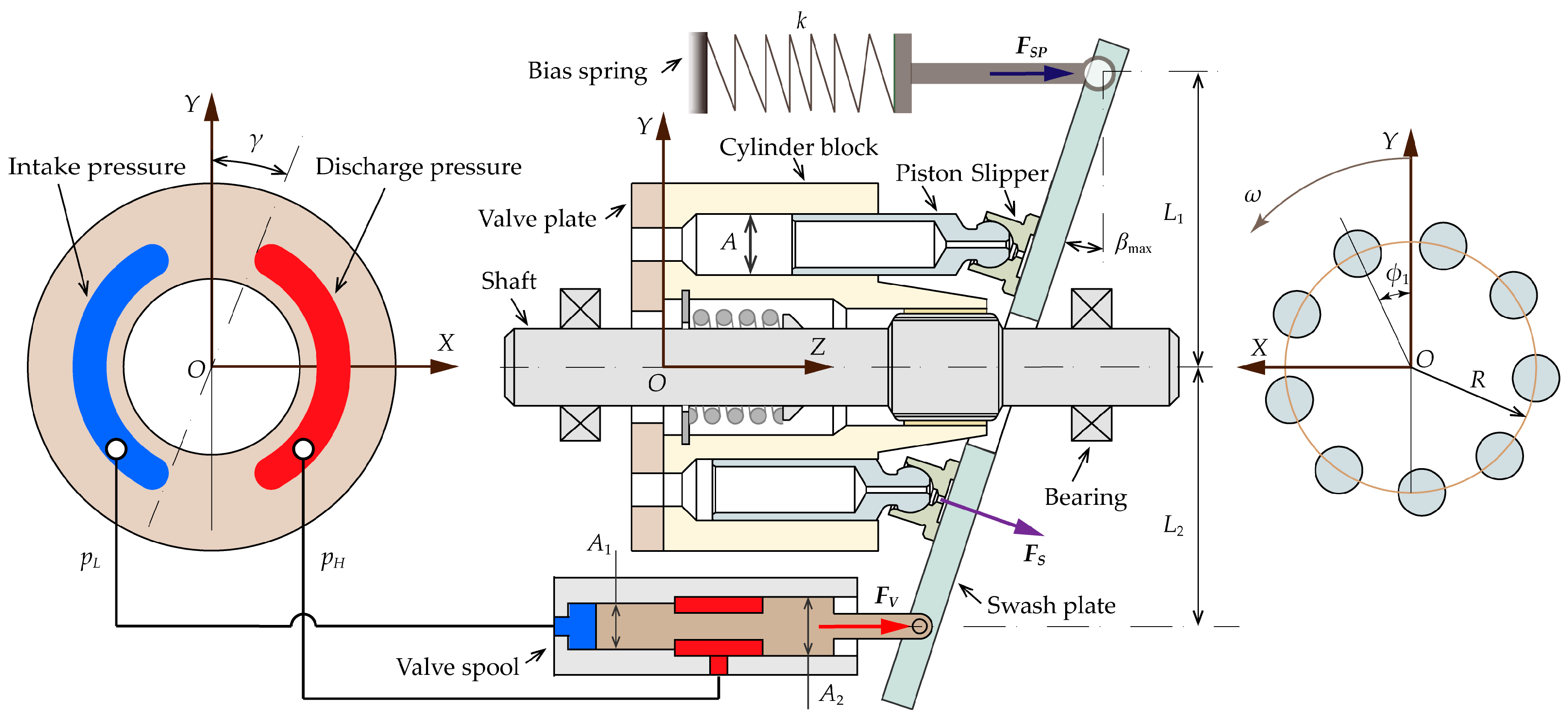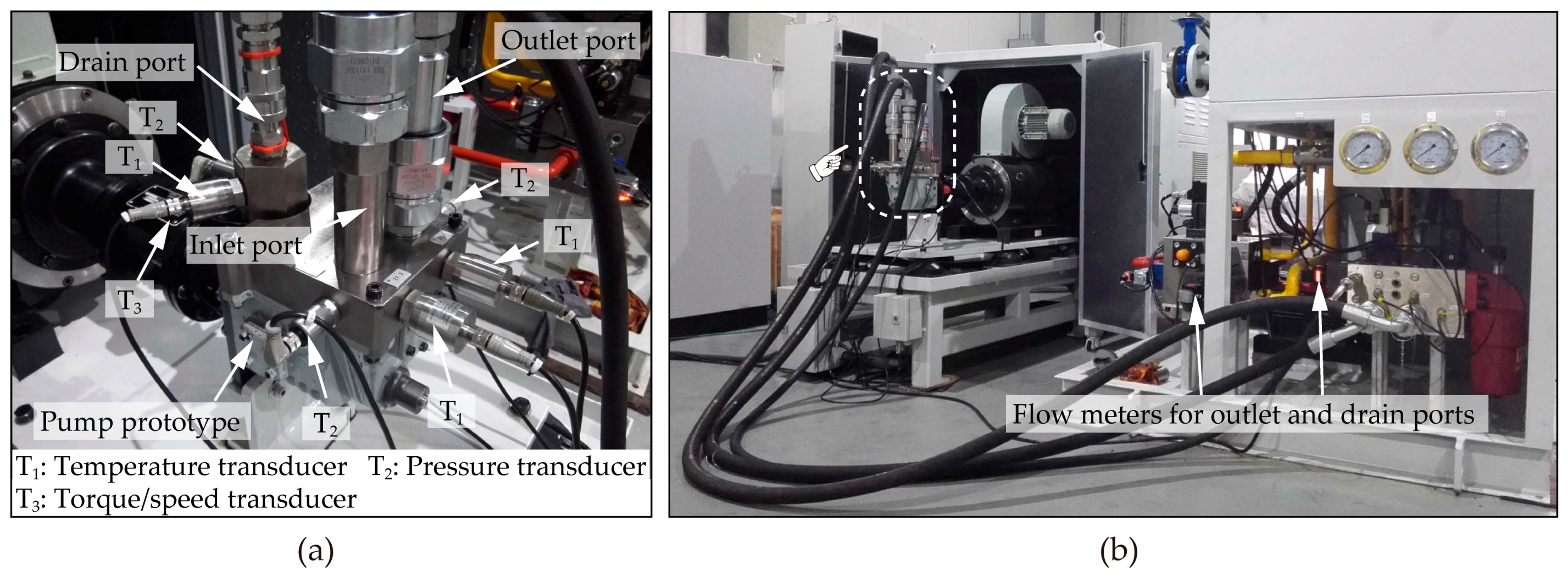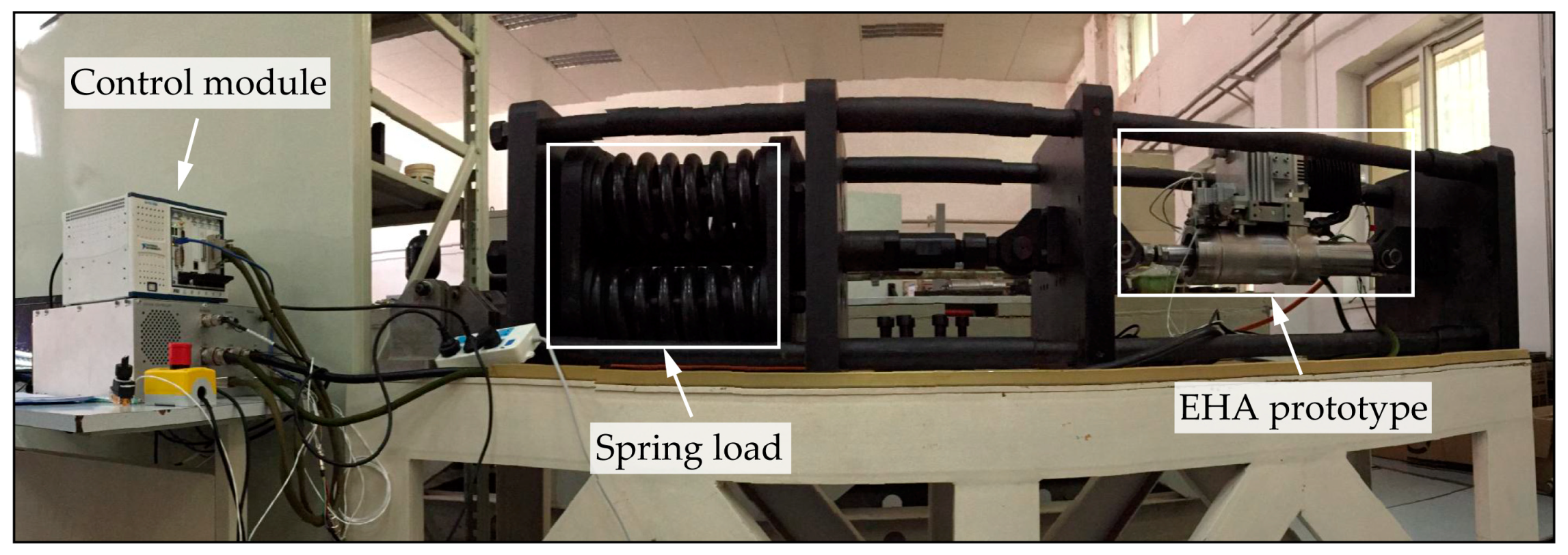Load-Sensing Pump Design to Reduce Heat Generation of Electro-Hydrostatic Actuator Systems
Abstract
:1. Introduction
2. Mathematical Analysis
3. Results and Discussion
4. Conclusions
Author Contributions
Funding
Conflicts of Interest
Nomenclature
| A | pressurized area of a single piston, m2 |
| A1 | cross area of valve spool, m2 |
| A2 | another cross area of valve spool, m2 |
| Cd | drag coefficient |
| d | piston diameter, m |
| FS | reaction force between swash plate and slippers, N |
| FSP | bias spring force, N |
| FV | valve spool force, N |
| G | volumetric displacement gain, m3/rad2 |
| I | armature current of electric motor, A |
| K | torque coefficient, Nm/A |
| k | bias spring stiffness, N/m |
| L | moment arm of FSP and FV, m |
| l0 | piston length out of the cylinder bore at bottom dead center, m |
| lc | length and the cylinder block, m |
| MPS | total mass of a single piston-slipper assembly, kg |
| N | number of pistons |
| pH | load pressure, Pa |
| pL | intake pressure, Pa |
| pH1 | load pressure for maximum volumetric displacement, Pa |
| pH2 | load pressure for minimum displacement, Pa |
| pHm | load pressure for maximum torque, Pa |
| R | resistance of stator windings, Ω |
| Rc | outer radius of the cylinder block, m |
| r | piston pitch radius, m |
| T | motor torque, Nm |
| t | gap height between the cylinder block and pump casing, m |
| TC | torque loss due to the churning loss of rotating group, Nm |
| TS | swivel torque produced by FS, Nm |
| Tmax | maximum motor torque, Nm |
| V | volumetric displacement, m3/rad |
| V1 | maximum volumetric displacement, m3/rad |
| V2 | minimum volumetric displacement, m3/rad |
| Vm | volumetric displacement for maximum torque, m3/rad |
| W | copper loss, J |
| x0 | initial compressed length of the bias spring, m |
| α | angular interval of cylinder bores |
| β | swash plate angle, rad |
| βmax | maximum swash plate angle, rad |
| γ | pressure carry-over angle on valve plate, rad |
| ηt | torque coefficient |
| λi | coefficient of ηt |
| μ | fluid dynamic viscosity, Pa·s |
| ρ | fluid density, kg/m3 |
| ω | rotational speed of pump, rad/s |
Abbreviations
| EHA | electro-hydrostatic actuator |
| EHA-FPVM | EHA with fixed pump displacement and variable motor speed |
| EHA-VPFM | EHA with variable pump displacement and fixed motor speed |
| EHA-VPVM | EHA with variable pump displacement and variable motor speed |
| MEA | more electric aircraft |
| PBW | power-by-wire |
References
- Roboam, X.; Sareni, B.; De Andrade, A. More electricity in the air: Toward optimized electrical networks embedded in more-electrical aircraft. IEEE Ind. Electron. Mag. 2012, 6, 6–17. [Google Scholar] [CrossRef]
- Maré, J.C.; Fu, J. Review on signal-by-wire and power-by-wire actuation for more electric aircraft. Chin. J. Aeronaut. 2017, 30, 857–870. [Google Scholar] [CrossRef]
- Alle, N.; Hiremath, S.S.; Makaram, S.; Subramaniam, K.; Talukdar, A. Review on electro hydrostatic actuator for flight control. Int. J. Fluid Power 2016, 17, 125–145. [Google Scholar] [CrossRef]
- Kang, R.J.; Jiao, Z.X.; Wang, S.P.; Chen, L.S. Design and simulation of electro-hydrostatic actuator with a built-in power regulator. Chin. J. Aeronaut. 2009, 22, 700–706. [Google Scholar] [CrossRef]
- Crowder, R.; Maxwell, C. Simulation of a prototype electrically powered integrated actuator for civil aircraft. Proc. Inst. Mech. Eng. Part G-J. Aerosp. Eng. 1997, 211, 381–394. [Google Scholar] [CrossRef]
- Chakraborty, I.; Mavris, D.N.; Emeneth, M.; Schneegans, A. A methodology for vehicle and mission level comparison of More Electric Aircraft subsystem solution: Application to the flight control actuation system. Proc. Inst. Mech. Eng. Part G-J. Aerosp. Eng. 2015, 229, 1088–1102. [Google Scholar] [CrossRef]
- Van den Bossche, D. The A380 flight control electro hydrostatic actuators, achievements and lessons learnt. In Proceedings of the 25th International Congress of the Aeronautical Sciences, Hamburg, Germany, 3–8 September 2006. [Google Scholar]
- Navarro, R. Performance of an electro-hydrostatic actuator on the F-18 systems research aircraft. In Proceedings of the 16th Digital Avionics Systems Conference, Irvine, CA, USA, 26–30 October 1997. [Google Scholar]
- Habibi, S.; Goldenberg, A. Design of a new high-performance electrohydraulic actuator. IEEE-ASME Trans. Mechatron. 2000, 5, 158–164. [Google Scholar] [CrossRef]
- Zhang, J.H.; Chao, Q.; Xu, B. Analysis of the cylinder block tilting inertia moment and its effect on the performance of high-speed electro-hydrostatic actuator pumps of aircraft. Chin. J. Aeronaut. 2018, 31, 169–177. [Google Scholar] [CrossRef]
- Huang, J.H.; Yan, Z.; Quan, L.; Lan, Y.; Gao, Y.S. Characteristics of delivery pressure in the axial piston pump with combination of variable displacement and variable speed. Proc. Inst. Mech. Eng. Part I-J Syst Control Eng. 2015, 229, 599–613. [Google Scholar] [CrossRef]
- Lovrec, D.; Ulaga, S. Pressure control in hydraulic systems with variable or constant pumps? Exp. Tech. 2007, 31, 33–41. [Google Scholar] [CrossRef]
- Tašner, T.; Les, K.; Tič, V.; Lovrec, D. Energy efficiency of different electrohydraulic drives. In Proceedings of the 9th International Fluid Power Conference, Aachen, Germany, 24–26 March 2014; pp. 14–25. [Google Scholar]
- Willkomm, J.; Wahler, M.; Weber, J. Process-adapted control to maximize dynamics of speed-and displacement-variable pumps. In Proceedings of the ASME/BATH 2014 Symposium on Fluid Power and Motion Control, Bath, UK, 10–12 September 2014. [Google Scholar] [CrossRef]
- Willkomm, J.; Wahler, M.; Weber, J. Potentials of speed and displacement variable pumps in hydraulic applications. In Proceedings of the 10th International Fluid Power Conference, Dresden, Germany, 8–10 March 2016; pp. 379–391. [Google Scholar]
- Mare, J.C.; Vinson, G.; Prado, T.; Combacau, M. Modelling and simulating the pump of an aerospace electro-hydrostatic module for fault detection and identification purposes. In Proceedings of the ASME/BATH 2014 Symposium on Fluid Power and Motion Control, Bath, UK, 10–12 September 2014. [Google Scholar] [CrossRef]
- Chen, W.Z.; Lin, T.; Hill, B.P.; Brown, J.R. Thermal modelling of a flight-critical electrohydrostatic actuator. In Proceedings of the Aerospace Atlantic Conference and Exposition, Dayton, OH, USA, 23–25 May 1995. [Google Scholar]
- Anderson, J.A. Variable displacement electro-hydrostatic actuator. In Proceedings of the IEEE 1991 National Aerospace and Electronics Conference, Dayton, OH, USA, 20–24 May 1991; pp. 529–534. [Google Scholar] [CrossRef]
- Gao, B.; Fu, Y.L.; Pei, Z.C.; Ma, J.M. Research on dual-variable integrated electro-hydrostatic actuator. Chin. J. Aeronaut. 2006, 19, 77–82. [Google Scholar] [CrossRef]
- Andersson, J.; Krus, P.; Nilsson, K. Optimization as a support for selection and design of aircraft actuation systems. In Proceedings of the 7th AIAA/USAF/NASA/ISSMO Symposium on Multidisciplinary Analysis and Optimization, St. Louis, MO, USA, 2–4 September 1998. [Google Scholar]
- Charrier, J.J.; Kulshreshtha, A. Electric actuation for flight and engine control: Evolution and challenges. In Proceedings of the 45th AIAA Aerospace Sciences Meeting and Exhibit, Reno, NV, USA, 8–11 January 2007. [Google Scholar]
- Kim, J.H.; Jeon, C.S.; Hong, Y.S. Constant pressure control of a swash plate type axial piston pump by varying both volumetric displacement and shaft speed. Int. J. Precis. Eng. Manuf. 2015, 16, 2395–2401. [Google Scholar] [CrossRef]
- Zhang, Y.; Fu, Y.L.; Zhou, W.X. Optimal control for EHA-VPVM system based on feedback linearization theory. In Proceedings of the 11th International Conference on Control, Automation, Robotics and Vision, Singapore, 7–10 December 2010; pp. 744–749. [Google Scholar] [CrossRef]
- Fu, Y.L.; Qi, H.T.; Lu, Y.L.; Guo, R.S.; Li, Z.F.; Xue, J.; Yang, Q. A novel electrical servo variable displacement hydraulic pump used for integrated actuator in MEA. In Proceedings of the 28th Congress of the International Council of the Aeronautical Sciences, Brisbane, Australia, 23–28 September 2012. [Google Scholar]
- Song, Z.N.; Jiao, Z.X.; Shang, Y.X.; Wu, S.; Hu, W.N. Design and analysis of a direct load sensing electro-hydrostatic actuator. In Proceedings of the 2015 International Conference on Fluid Power and Mechatronics, Harbin, China, 5–7 August 2015; pp. 624–627. [Google Scholar] [CrossRef]
- Frischemeier, S. Electrohydrostatic actuators for aircraft primary flight control-types, modelling and evaluation. In Proceedings of the 5th Scandinavian International Conference on Fluid Power, Linkoping, Sweden, 28–30 May 1997. [Google Scholar] [CrossRef]
- Manring, N.D. Fluid Power Pumps and Motors: Analysis, Design and Control, 1st ed.; McGraw-Hill Education: New York, NY, USA, 2013; pp. 107–116. [Google Scholar]
- Zhang, J.H.; Li, Y.; Xu, B.; Pan, M.; Lv, F. Experimental study on the influence of the rotating cylinder block and pistons on churning losses in axial piston pumps. Energies 2017, 10, 662. [Google Scholar] [CrossRef]
- Akers, A.; Zeiger, G. Torque on the swashplate of an axial piston pump. J. Dyn. Syst. Meas. Control-Trans. ASME 1985, 107, 220–226. [Google Scholar] [CrossRef]
- Kim, S.D.; Cho, H.S.; Lee, C.O. A parameter sensitivity analysis for the dynamic model of a variable displacement axial piston pump. Proc. Inst. Mech. Eng. Part C-J. Mech. Eng. Sci. 1987, 201, 235–243. [Google Scholar] [CrossRef]
- Manring, N.D.; Johnson, R.E. Modeling and designing a variable-displacement open-loop pump. J. Dyn. Syst. Meas. Control-Trans. ASME 1996, 118, 267–271. [Google Scholar] [CrossRef]
- Manring, N.D. The control and containment forces on the swash plate of an axial-piston pump. J. Dyn. Syst. Meas. Control-Trans. ASME 1999, 121, 599–605. [Google Scholar] [CrossRef]
- Manring, N.D. Designing a control and containment device for cradle-mounted, transverse-actuated swash plates. J. Mech. Des. 2001, 123, 447–455. [Google Scholar] [CrossRef]
- Manring, N.D. The torque on the input shaft of an axial-piston swash-plate type hydrostatic pump. J. Dyn. Syst. Meas. Control-Trans. ASME 1998, 120, 57–62. [Google Scholar] [CrossRef]
- Xu, B.; Chao, Q.; Zhang, J.H.; Chen, Y. Effects of the dimensional and geometrical errors on the cylinder block tilt of a high-speed EHA pump. Meccanica 2017, 52, 2449–2469. [Google Scholar] [CrossRef]
- Bügener, N.; Klecker, J.; Weber, J. Analysis and improvement of the suction performance of axial piston pumps in swash plate design. Int. J. Fluid Power 2014, 15, 153–167. [Google Scholar] [CrossRef]
- Kunkis, M.; Weber, J. Experimental and numerical assessment of an axial piston pump’s speed limit. In Proceedings of the BATH/ASME 2016 Symposium on Fluid Power and Motion Control, Bath, UK, 7–9 September 2016. [Google Scholar] [CrossRef]
- Zecchi, M.; Mehdizadeh, A.; Ivantysynova, M. A novel approach to predict the steady state temperature in ports and case of swash plate type axial piston machines. In Proceedings of the 13th Scandinavian International Conference on Fluid Power, Linköping, Sweden, 3–5 June 2013; pp. 177–187. [Google Scholar] [CrossRef]
- Li, Z.H.; Shang, Y.X.; Jiao, Z.X.; Lin, Y.; Wu, S.; Li, X.B. Analysis of the dynamic performance of an electro-hydrostatic actuator and improvement methods. Chin. J. Aeronaut. 2018. [Google Scholar] [CrossRef]
- Hu, W.N.; Zhou, L.; Tian, Y.S.; Jiao, Z.X.; Shang, Y.X.; Song, Z.N.; Yan, L. Analysis for the power loss of electro hydrostatic actuator and hydraulic actuator. In Proceedings of the 2015 IEEE International Conference on Advanced Intelligent Mechatronics (AIM), Busan, South Korea, 7–11 July 2015; pp. 613–616. [Google Scholar] [CrossRef]









© 2018 by the authors. Licensee MDPI, Basel, Switzerland. This article is an open access article distributed under the terms and conditions of the Creative Commons Attribution (CC BY) license (http://creativecommons.org/licenses/by/4.0/).
Share and Cite
Chao, Q.; Zhang, J.; Xu, B.; Shang, Y.; Jiao, Z.; Li, Z. Load-Sensing Pump Design to Reduce Heat Generation of Electro-Hydrostatic Actuator Systems. Energies 2018, 11, 2266. https://doi.org/10.3390/en11092266
Chao Q, Zhang J, Xu B, Shang Y, Jiao Z, Li Z. Load-Sensing Pump Design to Reduce Heat Generation of Electro-Hydrostatic Actuator Systems. Energies. 2018; 11(9):2266. https://doi.org/10.3390/en11092266
Chicago/Turabian StyleChao, Qun, Junhui Zhang, Bing Xu, Yaoxing Shang, Zongxia Jiao, and Zhihui Li. 2018. "Load-Sensing Pump Design to Reduce Heat Generation of Electro-Hydrostatic Actuator Systems" Energies 11, no. 9: 2266. https://doi.org/10.3390/en11092266





